Yamaha PSR-E413 User Manual
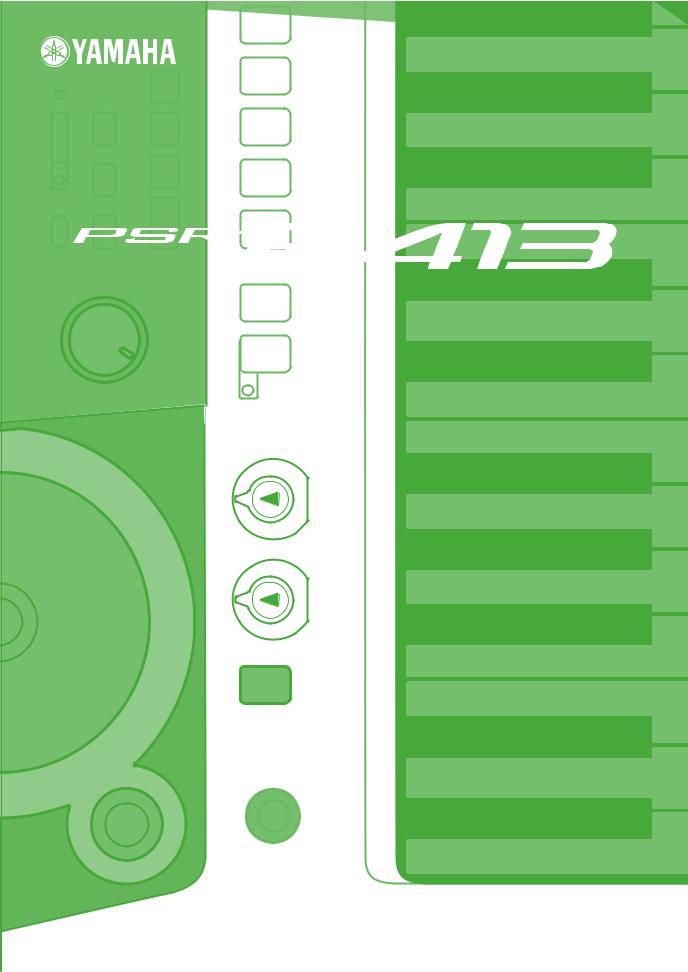
DIGITAL KEYBOARD
Owner’s Manual
EN |

SPECIAL MESSAGE SECTION
This product utilizes batteries or an external power supply (adapter). DO NOT connect this product to any power supply or adapter other than one described in the manual, on the name plate, or specifically recommended by Yamaha.
WARNING: Do not place this product in a position where anyone could walk on, trip over, or roll anything over power or connecting cords of any kind. The use of an extension cord is not recommended! If you must use an extension cord, the minimum wire size for a 25’ cord (or less) is 18 AWG. NOTE: The smaller the AWG number, the larger the current handling capacity. For longer extension cords, consult a local electrician.
This product should be used only with the components supplied or; a cart, rack, or stand that is recommended by Yamaha. If a cart, etc., is used, please observe all safety markings and instructions that accompany the accessory product.
SPECIFICATIONS SUBJECT TO CHANGE:
The information contained in this manual is believed to be correct at the time of printing. However, Yamaha reserves the right to change or modify any of the specifications without notice or obligation to update existing units.
This product, either alone or in combination with an amplifier and headphones or speaker/s, may be capable of producing sound levels that could cause permanent hearing loss. DO NOT operate for long periods of time at a high volume level or at a level that is uncomfortable. If you experience any hearing loss or ringing in the ears, you should consult an audiologist.
IMPORTANT: The louder the sound, the shorter the time period before damage occurs.
Some Yamaha products may have benches and / or accessory mounting fixtures that are either supplied with the product or as optional accessories. Some of these items are designed to be dealer assembled or installed. Please make sure that benches are stable and any optional fixtures (where applicable) are well secured BEFORE using.
Benches supplied by Yamaha are designed for seating only. No other uses are recommended.
Battery Notice:
This product MAY contain a small non-rechargeable battery which (if applicable) is soldered in place. The average life span of this type of battery is approximately five years. When replacement becomes necessary, contact a qualified service representative to perform the replacement.
This product may also use “household” type batteries. Some of these may be rechargeable. Make sure that the battery being charged is a rechargeable type and that the charger is intended for the battery being charged.
When installing batteries, do not mix batteries with new, or with batteries of a different type. Batteries MUST be installed correctly. Mismatches or incorrect installation may result in overheating and battery case rupture.
Warning:
Do not attempt to disassemble, or incinerate any battery. Keep all batteries away from children. Dispose of used batteries promptly and as regulated by the laws in your area. Note: Check with any retailer of household type batteries in your area for battery disposal information.
Disposal Notice:
Should this product become damaged beyond repair, or for some reason its useful life is considered to be at an end, please observe all local, state, and federal regulations that relate to the disposal of products that contain lead, batteries, plastics, etc. If your dealer is unable to assist you, please contact Yamaha directly.
NAME PLATE LOCATION:
The name plate is located on the bottom of the product. The model number, serial number, power requirements, etc., are located on this plate. You should record the model number, serial number, and the date of purchase in the spaces provided below and retain this manual as a permanent record of your purchase.
NOTICE:
Service charges incurred due to a lack of knowledge relating to how a function or effect works (when the unit is operating as designed) are not covered by the manufacturer’s warranty, and are therefore the owners responsibility. Please study this manual carefully and consult your dealer before requesting service.
Model
Serial No.
ENVIRONMENTAL ISSUES: |
Purchase Date |
Yamaha strives to produce products that are both user safe and environmentally friendly. We sincerely believe that our products and the production methods used to produce them, meet these goals. In keeping with both the letter and the spirit of the law, we want you to be aware of the following:
PLEASE KEEP THIS MANUAL
92-BP (bottom)
2 PSR-E413 Owner’s Manual

FCC INFORMATION (U.S.A.)
1. IMPORTANT NOTICE: DO NOT MODIFY THIS UNIT! |
not guarantee that interference will not occur in all installations. If |
|
This product, when installed as indicated in the instructions con- |
this product is found to be the source of interference, which can be |
|
tained in this manual, meets FCC requirements. Modifications not |
determined by turning the unit “OFF” and “ON”, please try to elimi- |
|
expressly approved by Yamaha may void your authority, granted by |
nate the problem by using one of the following measures: |
|
the FCC, to use the product. |
Relocate either this product or the device that is being affected by |
|
2. IMPORTANT: When connecting this product to accessories and/ |
the interference. |
|
or another product use only high quality shielded cables. Cable/s |
Utilize power outlets that are on different branch (circuit breaker or |
|
supplied with this product MUST be used. Follow all installation |
fuse) circuits or install AC line filter/s. |
|
instructions. Failure to follow instructions could void your FCC |
In the case of radio or TV interference, relocate/reorient the |
|
authorization to use this product in the USA. |
||
antenna. If the antenna lead-in is 300 ohm ribbon lead, change the |
||
3. NOTE: This product has been tested and found to comply with the |
||
lead-in to co-axial type cable. |
||
requirements listed in FCC Regulations, Part 15 for Class “B” digital |
If these corrective measures do not produce satisfactory results, |
|
devices. Compliance with these requirements provides a reason- |
||
please contact the local retailer authorized to distribute this type of |
||
able level of assurance that your use of this product in a residential |
||
product. If you can not locate the appropriate retailer, please contact |
||
environment will not result in harmful interference with other elec- |
||
Yamaha Corporation of America, Electronic Service Division, 6600 |
||
tronic devices. This equipment generates/uses radio frequencies |
||
Orangethorpe Ave, Buena Park, CA90620 |
||
and, if not installed and used according to the instructions found in |
||
The above statements apply ONLY to those products distributed by |
||
the users manual, may cause interference harmful to the operation |
||
Yamaha Corporation of America or its subsidiaries. |
||
of other electronic devices. Compliance with FCC regulations does |
||
|
||
|
|
|
* This applies only to products distributed by YAMAHA CORPORATION OF AMERICA. |
(class B) |
IMPORTANT NOTICE FOR THE UNITED KINGDOM
Connecting the Plug and Cord
IMPORTANT. The wires in this mains lead are coloured in accordance with the following code:
BLUE : NEUTRAL BROWN : LIVE
As the colours of the wires in the mains lead of this apparatus may not correspond with the coloured makings identifying the terminals in your plug proceed as follows:
The wire which is coloured BLUE must be connected to the terminal which is marked with the letter N or coloured BLACK.
The wire which is coloured BROWN must be connected to the terminal which is marked with the letter L or coloured RED.
Making sure that neither core is connected to the earth terminal of the three pin plug.
• This applies only to products distributed by |
(2 wires) |
Yamaha Music U.K. Ltd. |
|
COMPLIANCE INFORMATION STATEMENT (DECLARATION OF CONFORMITY PROCEDURE)
Responsible Party : Yamaha Corporation of America
Address : 6600 Orangethorpe Ave., Buena Park, Calif.
90620
Telephone : 714-522-9011
Type of Equipment : Digital Keyboard
Model Name : PSR-E413
This device complies with Part 15 of the FCC Rules. Operation is subject to the following two conditions:
1)this device may not cause harmful interference, and
2)this device must accept any interference received including interference that may cause undesired operation.
See user manual instructions if interference to radio reception is suspected.
* This applies only to products distributed by |
(FCC DoC) |
YAMAHA CORPORATION OF AMERICA. |
|
OBSERVERA!
Apparaten kopplas inte ur växelströmskällan (nätet) så länge som den ar ansluten till vägguttaget, även om själva apparaten har stängts av.
ADVARSEL: Netspæendingen til dette apparat er IKKE afbrudt, sålæenge netledningen siddr i en stikkontakt, som er t endt — også selvom der or slukket på apparatets afbryder.
VAROITUS: Laitteen toisiopiiriin kytketty käyttökytkin ei irroita koko laitetta verkosta.
(standby)
Entsorgung leerer Batterien (nur innerhalb Deutschlands)
Leisten Sie einen Beitrag zum Umweltschutz. Verbrauchte Batterien oder Akkumulatoren dürfen nicht in den Hausmüll. Sie können bei einer Sammelstelle für Altbatterien bzw. Sondermüll abgegeben werden. Informieren Sie sich bei Ihrer Kommune.
(battery)
PSR-E413 Owner’s Manual 3
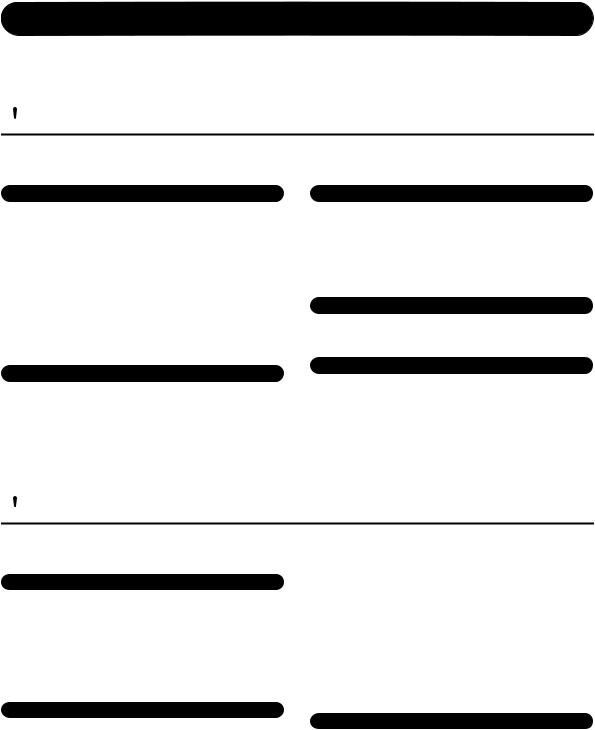
PRECAUTIONS
PLEASE READ CAREFULLY BEFORE PROCEEDING
* Please keep this manual in a safe place for future reference.
 WARNING
WARNING
Always follow the basic precautions listed below to avoid the possibility of serious injury or even death from electrical shock, short-circuiting, damages, fire or other hazards. These precautions include, but are not limited to, the following:
Power supply/AC power adaptor |
|
Water warning |
•Only use the voltage specified as correct for the instrument. The required voltage is printed on the name plate of the instrument.
•Use the specified adaptor (PA-130 or an equivalent recommended by Yamaha) only. Using the wrong adaptor can result in damage to the instrument or overheating.
•Check the electric plug periodically and remove any dirt or dust which may have accumulated on it.
•Do not place the AC adaptor cord near heat sources such as heaters or radiators, and do not excessively bend or otherwise damage the cord, place heavy objects on it, or place it in a position where anyone could walk on, trip over, or roll anything over it.
•Do not expose the instrument to rain, use it near water or in damp or wet conditions, or place containers on it containing liquids which might spill into any openings. If any liquid such as water seeps into the instrument, turn off the power immediately and unplug the power cord from the AC outlet. Then have the instrument inspected by qualified Yamaha service personnel.
•Never insert or remove an electric plug with wet hands.
Fire warning
•Do not put burning items, such as candles, on the unit. A burning item may fall over and cause a fire.
Do not open
•Do not open the instrument or attempt to disassemble the internal parts or modify them in any way. The instrument contains no user-serviceable parts. If it should appear to be malfunctioning, discontinue use immediately and have it inspected by qualified Yamaha service personnel.
If you notice any abnormality
•If the AC adaptor cord or plug becomes frayed or damaged, or if there is a sudden loss of sound during use of the instrument, or if any unusual smells or smoke should appear to be caused by it, immediately turn off the power switch, disconnect the adaptor plug from the outlet, and have the instrument inspected by qualified Yamaha service personnel.
 CAUTION
CAUTION
Always follow the basic precautions listed below to avoid the possibility of physical injury to you or others, or damage to the instrument or other property. These precautions include, but are not limited to, the following:
Power supply/AC power adaptor
•When removing the electric plug from the instrument or an outlet, always hold the plug itself and not the cord.
•Unplug the AC power adaptor when not using the instrument, or during electrical storms.
•Do not connect the instrument to an electrical outlet using a multiple-connector. Doing so can result in lower sound quality, or possibly cause overheating in the outlet.
•Do not attempt to recharge batteries that are not intended to be charged.
•When the batteries run out, or if the instrument is not to be used for a long time, remove the batteries from the instrument to prevent possible leakage of the battery fluid.
•Keep batteries away from children.
•If the batteries do leak, avoid contact with the leaked fluid. If the battery fluid should come in contact with your eyes, mouth, or skin, wash immediately with water and consult a doctor. Battery fluid is corrosive and may possibly cause loss of sight or chemical burns.
Battery
•Always make sure all batteries are inserted in conformity with the +/- polarity markings. Failure to do so might result in overheating, fire, or battery fluid leakage.
•Always replace all batteries at the same time. Do not use new batteries together with old ones. Also, do not mix battery types, such as alkaline batteries with manganese batteries, or batteries from different makers, or different types of batteries from the same maker, since this can cause overheating, fire, or battery fluid leakage.
•Do not dispose of batteries in fire.
Location
•Do not expose the instrument to excessive dust or vibrations, or extreme cold or heat (such as in direct sunlight, near a heater, or in a car during the day) to prevent the possibility of panel disfiguration or damage to the internal components.
•Do not use the instrument in the vicinity of a TV, radio, stereo equipment, mobile phone, or other electric devices. Otherwise, the instrument, TV, or radio may generate noise.
•Do not place the instrument in an unstable position where it might accidentally fall over.
(4)-12 1/2
4 PSR-E413 Owner’s Manual
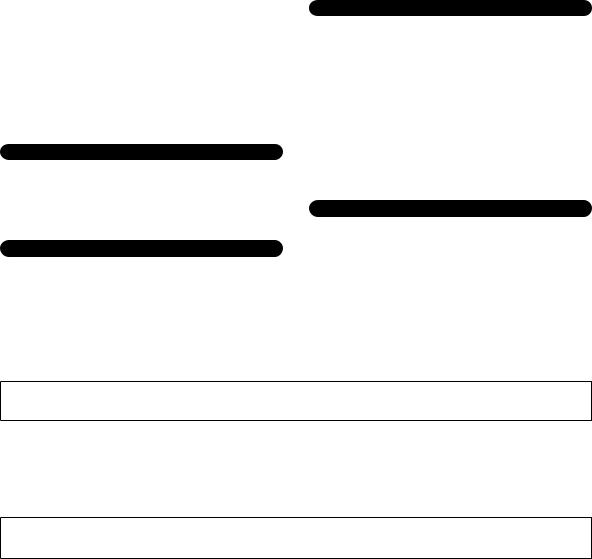
•Before moving the instrument, remove all connected adaptor and other cables.
•When setting up the product, make sure that the AC outlet you are using is easily accessible. If some trouble or malfunction occurs, immediately turn off the power switch and disconnect the plug from the outlet. Even when the power switch is turned off, electricity is still flowing to the product at the minimum level. When you are not using the product for a long time, make sure to unplug the power cord from the wall AC outlet.
•Use only the stand specified for the instrument. When attaching the stand or rack, use the provided screws only. Failure to do so could cause damage to the internal components or result in the instrument falling over.
Connections
•Before connecting the instrument to other electronic components, turn off the power for all components. Before turning the power on or off for all components, set all volume levels to minimum. Also, be sure to set the volumes of all components at their minimum levels and gradually raise the volume controls while playing the instrument to set the desired listening level.
Maintenance
•When cleaning the instrument, use a soft, dry cloth. Do not use paint thinners, solvents, cleaning fluids, or chemical-impregnated wiping cloths.
Handling caution
•Do not insert a finger or hand in any gaps on the instrument.
•Never insert or drop paper, metallic, or other objects into the gaps on the panel or keyboard. If this happens, turn off the power immediately and unplug the power cord from the AC outlet. Then have the instrument inspected by qualified Yamaha service personnel.
•Do not place vinyl, plastic or rubber objects on the instrument, since this might discolor the panel or keyboard.
•Do not rest your weight on, or place heavy objects on the instrument, and do not use excessive force on the buttons, switches or connectors.
•Do not use the instrument/device or headphones for a long period of time at a high or uncomfortable volume level, since this can cause permanent hearing loss. If you experience any hearing loss or ringing in the ears, consult a physician.
Saving data
Saving and backing up your data
•The panel settings and some other types of data are not retained in memory when you turn off the power to the instrument. Save data you want to keep to the Registration Memory (page 80.)
Saved data may be lost due to malfunction or incorrect operation. Save important data to an external device such as a computer (pages 92).
Yamaha cannot be held responsible for damage caused by improper use or modifications to the instrument, or data that is lost or destroyed.
Always turn the power off when the instrument is not in use.
When using a power adaptor, even when the power switch is in the “STANDBY” position, electricity is still flowing to the instrument at the minimum level. When you are not using the instrument for a long time, make sure you unplug the AC power adaptor from the wall AC outlet.
Make sure to discard used batteries according to local regulations.
The illustrations and LCD screens as shown in this manual are for instructional purposes only, and may appear somewhat different from those on your instrument.
● Trademarks
•Windows is a registered trademark of Microsoft® Corporation in the United States and other countries.
•The company names and product names in this manual are the trademarks or registered trademarks of their respective companies.
(4)-12 2/2
PSR-E413 Owner’s Manual 5
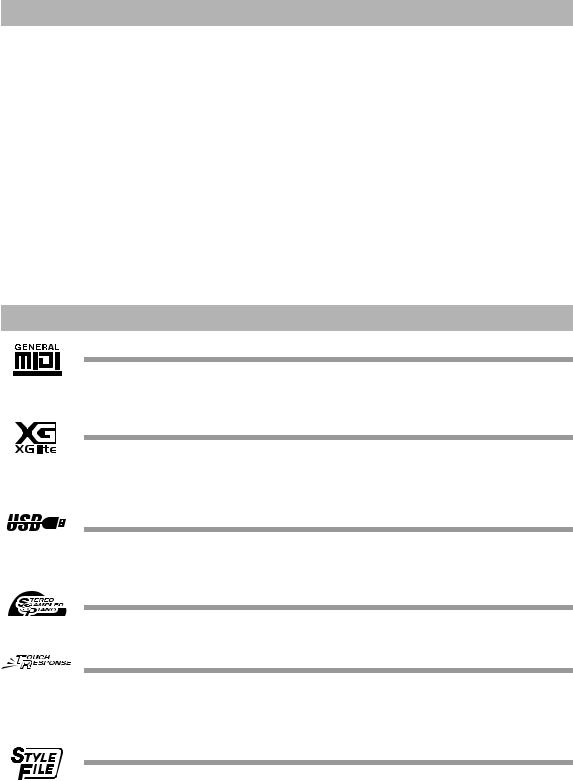
Copyright Notice
The following is the title, credits and copyright notices for the song pre-installed in this electronic keyboard:
Composition Title: Against All Odds
Composer’s Name: Collins 0007403
Copyright Owner’s Name: EMI MUSIC PUBLISHING LTD AND HIT & RUN MUSIC LTD
All Rights Reserved, Unauthorized copying, public performance and broadcasting are strictly prohibited.
This product incorporates and bundles computer programs and contents in which Yamaha owns copyrights or with respect to which it has license to use others’ copyrights. Such copyrighted materials include, without limitation, all computer software, style files, MIDI files, WAVE data, musical scores and sound recordings. Any unauthorized use of such programs and contents outside of personal use is not permitted under relevant laws. Any violation of copyright has legal consequences. DON’T MAKE, DISTRIBUTE OR USE ILLEGAL COPIES.
Copying of the commercially available musical data including but not limited to MIDI data and/or audio data is strictly prohibited except for your personal use.
Logos
GM System Level 1
“GM System Level 1” is an addition to the MIDI standard which ensures that any GM-compatible music data can be accurately played by any GM-compatible tone generator, regardless of manufacturer. The GM mark is affixed to all software and hardware products that support GM System Level.
XGlite
As its name implies, “XGlite” is a simplified version of Yamaha’s high-quality XG tone generation format. Naturally, you can play back any XG song data using an XGlite tone generator. However, keep in mind that some songs may play back differently compared to the original data, due to the reduced set of control parameters and effects.
USB
USB is an abbreviation for Universal Serial Bus. It is a serial interface for connecting a computer with peripheral Devices. It allows “hot swapping” (connecting peripheral devices while the power to the computer is on).
Stereo Sampled Piano
The instrument has a special Portable Grand Piano Voice—created by state-of-the-art stereo sampling technology and using Yamaha’s sophisticated AWM (Advanced Wave memory) tone generation system.
Touch Response
The exceptionally natural Touch Response feature, with a convenient front panel on/off switch, gives you maximum expressive level control over the voices. It also works in conjunction with the Dynamic Filter, which dynamically adjusts the timbre or tone of a voice according to your playing strength—just a like a real musical instrument!
STYLE FILE
The Style File Format is Yamaha’s original style file format which uses a unique conversion system to provide high-quality automatic accompaniment based on a wide range of chord types.
6 PSR-E413 Owner’s Manual
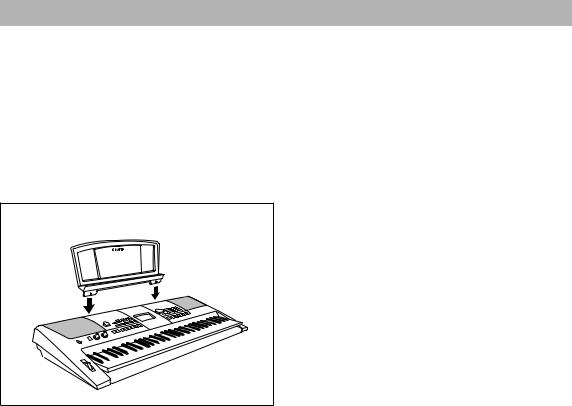
Congratulations and thank you for purchasing the Yamaha PSR-E413 Digital Keyboard!
Please read this owner’s manual carefully before using the instrument in order to take full advantage of its various features.
Make sure to keep this manual in a safe and handy place even after you finish reading, and refer to it often when you need to better understand an operation or function.
Included Accessories
The PSR-E413 package includes the following items. Please check that you have them all.
•Owner’s Manual
•Music rest
•Accessory CD-ROM
● Music Rest |
Insert the music rest |
into the slots as shown. |
PSR-E413 Owner’s Manual 7
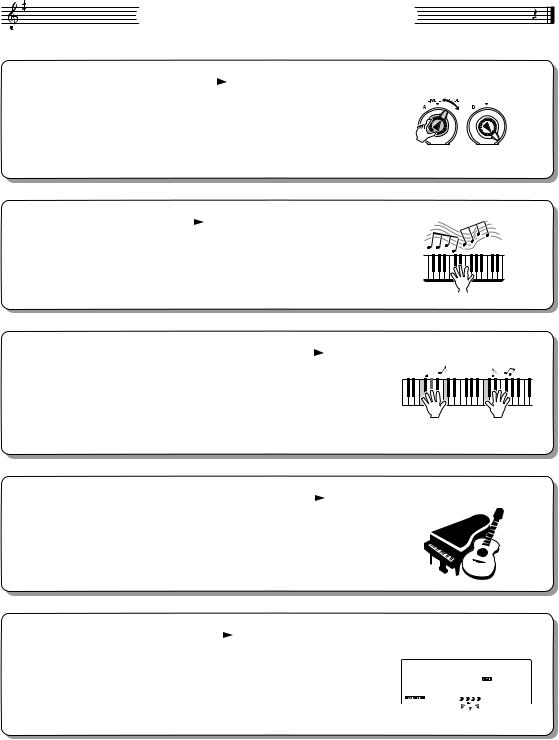
Special Features of the PSR-E413
■ Creating New Sounds |
Page 18 |
By adjusting just two knobs you can add varying degrees of distortion, “sweetness,” or other characteristics to a sound to change it subtly or drastically. Parameters that can be assigned to the knobs include effect, filter, envelope generator and more. You can create new sounds in real time!
■ Arpeggio Function |
Page 14 |
Similar to the arpeggio functions provided on some synthesizers, this function automatically produces arpeggios (broken chords) when you simply play the appropriate notes on the keyboard. A variety of arpeggios can be produced by changing your fingering or the arpeggio type.
■ Performance assistant technology |
Page 23 |
Play along with a song on the instrument’s keyboard and produce a perfect performance every time ... even if you play wrong notes! All you have to do is play on the keyboard—alternately on the leftand right-hand ranges of the keyboard, for example—and you’ll sound like a pro as long as you play in time with the music.
■ Play a Variety of Instrument Voices |
|
Page 28 |
|
The instrument voice that sounds when you play the keyboard can be changed to violin, flute, harp, or any of an extensive range of voices. You can change the mood of a song written for piano, for example, by using violin to play it instead. Experience a whole new world of musical variety.
■ Play Along with Styles |
Page 33 |
Want to play with full accompaniment? Try the auto-accompaniment Styles. The accompaniment styles provide the equivalent of a full backing band covering a wide variety of styles from waltzes to 8-beat to euro-trance ... and much more. Select a style that matches the music you want to play, or experiment with new styles to expand your musical horizons.
8 PSR-E413 Owner’s Manual
PopBossa
102
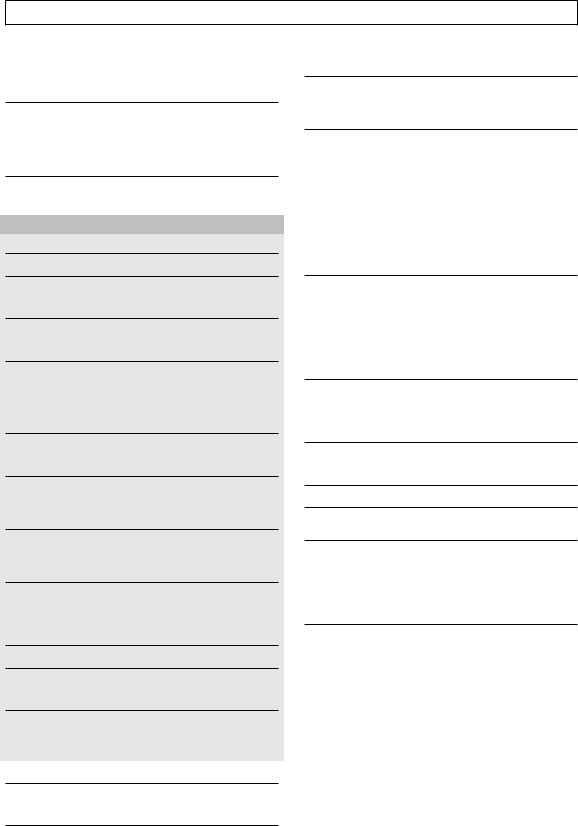
Contents
Copyright Notice .................................................................... |
6 |
Logos ..................................................................................... |
6 |
Included Accessories ............................................................. |
7 |
Special Features of the PSR-E413 ........................................ |
8 |
Setting Up |
10 |
Power Requirements ........................................................... |
10 |
Connecting Headphones (PHONES/OUTPUT Jack)........... |
11 |
Connecting a Footswitch (SUSTAIN Jack) .......................... |
11 |
Connecting to a Computer (USB Terminal) ......................... |
11 |
Turning the Power On.......................................................... |
11 |
Panel Controls and Terminals |
12 |
Front Panel .......................................................................... |
12 |
Rear Panel ........................................................................... |
13 |
Quick Guide |
|
Creating Arpeggios |
14 |
Create Original Sounds |
18 |
Assigning Effects to the Knobs ............................................ |
18 |
Using the Knobs................................................................... |
21 |
The Easy Way to Play Piano |
23 |
Play with Both Hands........................................................... |
23 |
Change the Song Tempo..................................................... |
27 |
Try Playing a Variety of Instrument Voices |
28 |
Select and Play a Voice—MAIN .......................................... |
28 |
Play Two Voices Simultaneously—DUAL............................ |
29 |
Play Different Voices with the Left and Right Hands |
|
—SPLIT .......................................................................... |
30 |
Play the Grand Piano Voice................................................. |
31 |
Fun Sounds |
32 |
Drum Kits ............................................................................. |
32 |
Sound Effects....................................................................... |
32 |
Playing Styles |
33 |
Select a Style Rhythm.......................................................... |
33 |
Play Along with a Style ........................................................ |
34 |
Playing Auto-accompaniment Chords.................................. |
38 |
Using Songs |
39 |
Select and Listen to a Song ................................................. |
39 |
Song Fast Forward, Fast Reverse, and Pause.................... |
40 |
Types of Songs .................................................................... |
42 |
Select a Song For a Lesson |
43 |
Lesson 1—Waiting............................................................... |
43 |
Lesson 2—Your Tempo ....................................................... |
46 |
Lesson 3—Minus One ......................................................... |
47 |
Practice Makes Perfect—Repeat and Learn........................ |
48 |
Play Using the Music Database |
49 |
Change a Song’s Style |
50 |
Listen to the DEMO Song for Easy Song Arranger.............. |
50 |
Using the Easy Song Arranger ............................................ |
50 |
Record Your Own Performance |
52 |
Recording Procedure ........................................................... |
52 |
Song Clear—Deleting User Songs ...................................... |
55 |
Track Clear—Deleting a Specified Track |
|
from a User Song............................................................ |
55 |
Backup and Initialization |
56 |
Backup ................................................................................. |
56 |
Initialization .......................................................................... |
56 |
Basic Operation and Displays |
57 |
Basic Operation ................................................................... |
57 |
Display Items ....................................................................... |
59 |
Reference |
|
Adding Effects |
60 |
Harmony............................................................................... |
60 |
Adding Reverb ..................................................................... |
61 |
Adding Chorus ..................................................................... |
62 |
Handy Performance Features |
63 |
The Metronome.................................................................... |
63 |
Setting the Number of Beats per Measure, |
|
and the Length of Each Beat .......................................... |
64 |
Adjusting the Metronome Volume ........................................ |
64 |
Tap Start .............................................................................. |
65 |
Touch Response Sensitivity................................................. |
65 |
Pitch Bend............................................................................ |
66 |
Pitch Controls....................................................................... |
66 |
Controlling Arpeggio Volume with Keyboard Dynamics....... |
67 |
One Touch Setting ............................................................... |
68 |
Adjusting the Harmony Volume............................................ |
69 |
Select an EQ Setting for the Best Sound ............................. |
69 |
Style (Auto-accompaniment) Functions |
70 |
Pattern Variation (Sections) ................................................. |
70 |
Adjusting the Style Volume .................................................. |
72 |
Setting the Split Point........................................................... |
72 |
Play a Style with Chords but No Rhythm |
|
(Stop Accompaniment) ................................................... |
73 |
Loading Style Files............................................................... |
74 |
Chord Basics........................................................................ |
75 |
Looking Up Chords Using the Chord Dictionary .................. |
77 |
Song Settings |
78 |
Song Volume........................................................................ |
78 |
A-B Repeat........................................................................... |
78 |
Muting Independent Song Parts........................................... |
79 |
Change the Melody Voice .................................................... |
79 |
Memorize Your Favorite Panel Settings |
80 |
Saving to the Registration Memory ...................................... |
80 |
Recalling a Registration Memory ......................................... |
81 |
Setting the Sleep Mode |
82 |
The Functions |
83 |
Selecting and Setting Functions........................................... |
83 |
Connecting to a Computer |
86 |
What Is MIDI? ...................................................................... |
86 |
Connecting a Personal Computer ........................................ |
87 |
Transferring Performance Data to and from a Computer..... |
88 |
Remote Control of MIDI Devices.......................................... |
89 |
Initial Send ........................................................................... |
90 |
Transferring Data between the Computer and Instrument... |
90 |
Accessory CD-ROM Installation Guide |
93 |
Important Notices about the CD-ROM ................................. |
93 |
CD-ROM Contents ............................................................... |
94 |
System Requirements.......................................................... |
95 |
Software Installation............................................................. |
95 |
Appendix |
|
Troubleshooting................................................................. |
99 |
Scores ............................................................................... |
100 |
Voice List ......................................................................... |
106 |
Drum Kit List .................................................................... |
110 |
Style List ........................................................................... |
112 |
Arpeggio List.................................................................... |
113 |
Music Database List ........................................................ |
114 |
Songs Provided On the Supplied CD-ROM ................... |
116 |
Effect Type List ................................................................ |
117 |
MIDI Implementation Chart ............................................. |
118 |
MIDI Data Format ............................................................. |
120 |
Specifications................................................................... |
123 |
Index.................................................................................. |
124 |
PSR-E413 Owner’s Manual 9
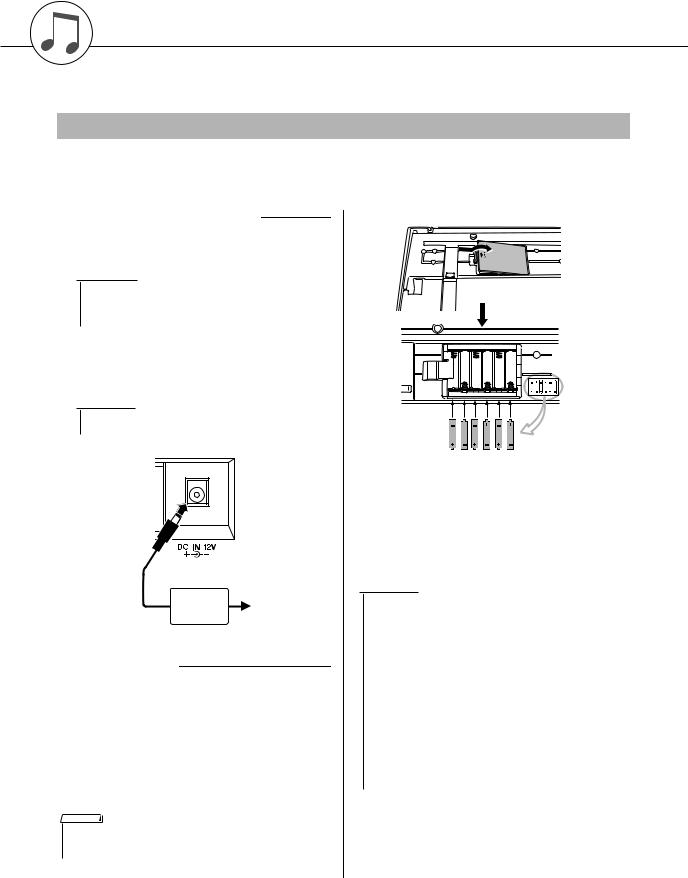
Setting Up
Be sure to do the following operations BEFORE turning on the power.
Power Requirements
Although the instrument will run either from an optional AC adaptor or batteries, Yamaha recommends use of an AC adaptor whenever possible. An AC adaptor is more environmentally friendly than batteries and does not deplete resources.
■ Using an AC Power Adaptor
Make sure that the [STANDBY/ON] switch of the instrument is set to STANDBY.
 WARNING
WARNING
•Use the specified adaptor (PA-130 or an equivalent recommended by Yamaha) only. The use of other adaptors may result in irreparable damage to both the adaptor and the instrument.
Connect the AC adaptor to the power supply jack.
Plug the AC adaptor into an AC outlet.
 CAUTION
CAUTION
•Unplug the AC Power Adaptor when not using the instrument, or during electrical storms.
|
|
|
|
AC power |
AC outlet |
|
adaptor |
||
|
■ Using Batteries
Open the battery compartment cover located on the instrument’s bottom panel.
Insert the six new batteries, being careful to follow the polarity markings on the inside of the compartment.
Replace the compartment cover, making sure that it locks firmly in place.
NOTE
•Connecting the AC power adaptor automatically supplies power from the adaptor and overrides battery power, even when batteries are installed.
For battery operation the instrument requires six 1.5V “AA” size, LR6 or equivalent batteries. (Alkaline batteries are recommended.) When battery power becomes too low for proper operation, make sure to replace all batteries, following the precautions listed below.
If necessary, also make sure to save all important User data (see page 56), since custom panel settings are lost when the batteries are removed.
 CAUTION
CAUTION
•Use only manganese or alkaline batteries for this instrument. Other types of batteries (including rechargeable batteries) may exhibit a sudden drop in power when the batteries are low, possibly resulting in a loss of flash memory data.
•Be sure to install the batteries in the same direction, maintaining the correct polarity (as shown). Incorrect battery installation may result in heat, fire and/or leaking of corrosive chemicals.
•When the batteries run down, replace them with a complete set of six new batteries. NEVER mix old and new batteries. Do not use different kinds of batteries (e.g. alkaline and manganese) at the same time.
•If the instrument will not be used for an extended period of time, remove the batteries to prevent possible fluid leakage.
•Please use the power adaptor when transferring data to flash memory. Batteries (including rechargeable types) can be drained rapidly by this type of operation. If the batteries do become drained during a data transfer, both the data being transferred and the data currently in the transfer destination will be lost.
10 PSR-E413 Owner’s Manual
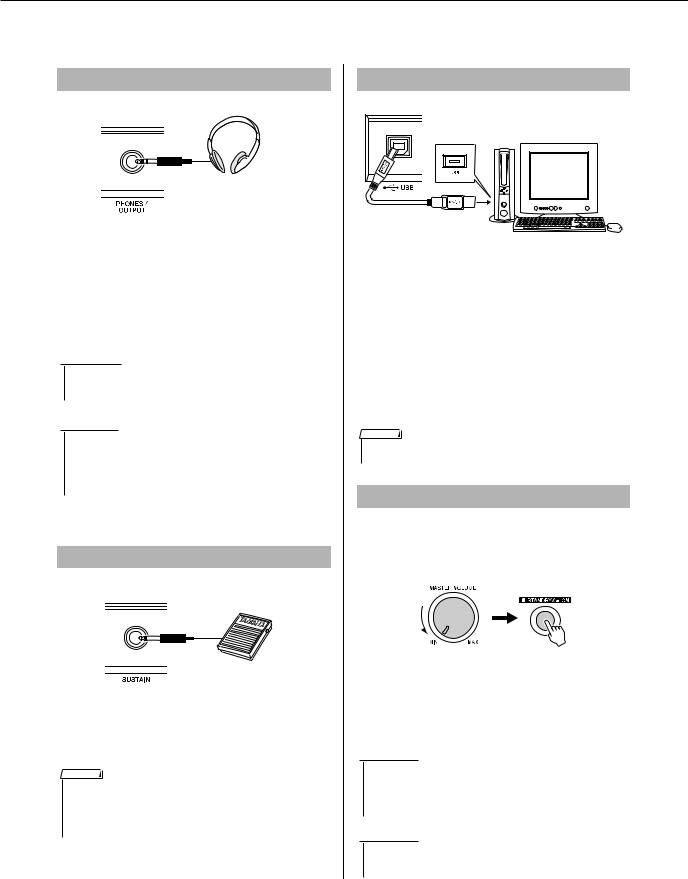
Setting Up
Make all necessary connections below BEFORE turning the power on.
Connecting Headphones (PHONES/OUTPUT Jack)
The PSR-E413 speakers are automatically shut off when a plug is inserted into this jack.
The PHONES/OUTPUT jack also functions as an external output. You can connect the PHONES/OUTPUT jack to a keyboard amplifier, stereo system, mixer, tape recorder, or other line-level audio device to send the instrument’s output signal to that device.
 WARNING
WARNING
•Avoid listening with the headphones at high volume for long periods of time; doing so may not only result in ear fatigue, it may be damaging to your hearing.
 CAUTION
CAUTION
•To prevent damage to the speakers, set the volume of the external devices at the minimum setting before connecting them. Failure to observe these cautions may result in electric shock or equipment damage. Also, be sure to set the volumes of all devices at their minimum levels and gradually raise the volume controls while playing the instrument to set the desired listening level.
Connecting a Footswitch (SUSTAIN Jack)
The sustain function lets you produce a natural sustain as you play by pressing a footswitch. Plug the Yamaha FC4 or FC5 footswitch into this jack and use it to switch sustain on and off.
NOTE
•Make sure that the footswitch plug is properly connected to the SUSTAIN jack before turning on the power.
•Do not press the footswitch while turning the power on. Doing this changes the recognized polarity of the footswitch, resulting in reversed footswitch operation.
Connecting to a Computer (USB Terminal)
Connect the instrument’s USB terminal to the USB terminal of a computer, and you can transfer performance data and song files between the two (page 87). To use the USB data-transfer features you’ll need to do the following:
•First, make sure the POWER switch on the instrument is set to OFF, then use an AB type USB cable to connect the instrument to the computer. After making the connections, turn on the power of the instrument.
•Install the USB-MIDI driver on your computer.
Installation of the USB-MIDI driver is described on page 95.
NOTE
•Make sure to purchase a quality USB cable at a musical instrument store, computer store or electrical appliance store.
Turning the Power On
Turn down the volume by turning the [MASTER VOLUME] control to the left and press the [STANDBY/ON] switch to turn on the power. Press the [STANDBY/ON] switch again to turn the power OFF.
Backup data in the flash memory is loaded to the instrument when the power is turned on. If no backup data exists on flash memory, all instrument settings are restored to the initial factory defaults when the power is turned on.
 CAUTION
CAUTION
•Even when the switch is in the “STANDBY” position, electricity is still flowing to the instrument at the minimum level. When you are not using the instrument for a long time, make sure you unplug the AC power adaptor from the wall AC outlet, and/or remove the batteries from the instrument.
 CAUTION
CAUTION
•Never attempt to turn the power off when a “WRITING!” message is shown in the display. Doing so can damage the flash memory and result in data loss.
PSR-E413 Owner’s Manual 11
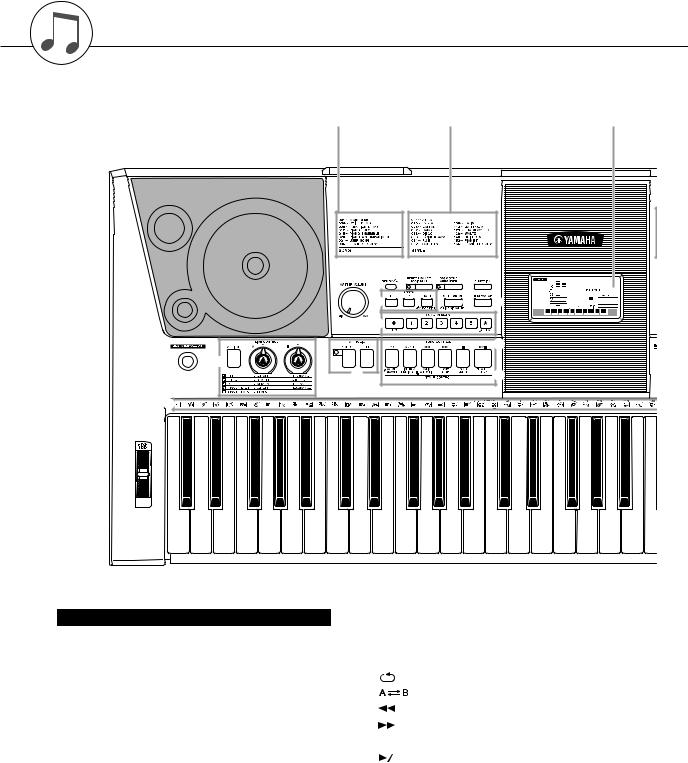
Panel Controls and Terminals
Front Panel
|
Song Category List |
Style Category List |
Display |
||||
|
(page 41) |
|
(page 112) |
|
(page 59) |
||
|
e |
r |
t |
y |
u |
|
|
|
|
|
|
|
GrandPno |
||
|
|
|
|
|
|
||
|
|
|
|
|
|
001 |
001 |
|
|
i |
|
o |
!0 |
|
|
|
|
|
|
|
|||
|
|
!1 |
|
|
|
|
|
|
|
|
|
|
!3 |
|
|
q |
w |
|
|
|
|
|
|
|
!2 |
|
|
|
!4 |
|
|
@6 |
|
|
|
|
|
|
|
@5
Front Panel
q [STANDBY/ON] switch .................... |
page 11 |
w LIVE CONTROL |
|
[ASSIGN] button .............................. |
page 18 |
[A] and [B] knobs ............................ |
page 21 |
e [MASTER VOLUME] control.... |
pages 11, 57 |
r [DEMO/PC] button ........................... |
page 40 |
t [PERFORMANCE ASSISTANT] |
|
button ............................................... |
page 23 |
y [EASY SONG ARRANGER] |
|
button ............................................... |
page 50 |
u [FUNCTION] button ......................... |
page 83 |
i LESSON |
|
[L], [R] buttons................................. |
page 44 |
[START] button ................................ |
page 44 |
o [METRONOME] button .................... |
page 63 |
!0[TEMPO/TAP] button ....................... |
page 27 |
!1SONG MEMORY |
|
[REC], [1]–[5], [A] buttons............... |
page 52 |
!2ARPEGGIO |
|
||||||
[ON/OFF] button.............................. |
page 14 |
||||||
[TYPE] button .................................. |
page 15 |
||||||
!3SONG CONTROL |
|
||||||
[ |
|
|
|
|
] (REPEAT & LEARN) button page 48... |
||
[ |
|
|
|
|
|
] (A-B REPEAT) button ......... |
page 78 |
[ |
|
|
|
|
] (REW) button .......................... |
page 40 |
|
[ |
|
|
|
|
] (FF) button .............................. |
page 40 |
|
[ |
|
|
|
] (PAUSE) button |
page 40 |
||
|
|
||||||
|
|
||||||
[ |
|
|
|
|
|
] (START/STOP) button |
pages 40, 58 |
|
|
|
|
|
|||
|
|
|
|
|
|||
!4STYLE CONTROL |
|
||||||
[ACMP ON/OFF] button .................. |
page 34 |
||||||
[INTRO/ENDING/rit.] button............ |
page 71 |
||||||
[MAIN/AUTO FILL] button............... |
page 71 |
||||||
[SYNC STOP] button....................... |
page 71 |
||||||
[SYNC START] button..................... |
page 70 |
||||||
[START/STOP] button .............. |
pages 33, 58 |
||||||
12 PSR-E413 Owner’s Manual
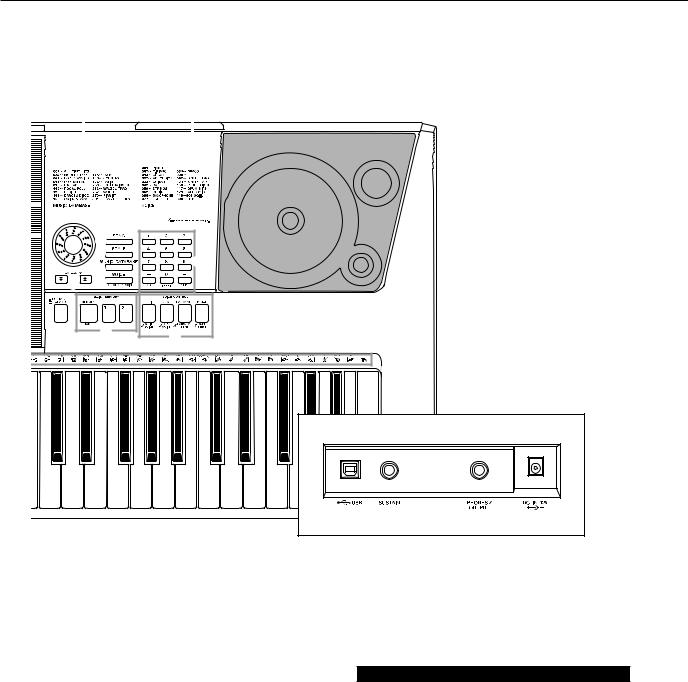
Panel Controls and Terminals
Music Database List |
Voice Category List |
||||||||||
|
|
|
(page 114) |
|
|
|
|
(page 106) |
|||
|
|
|
|
|
|
||||||
|
|
|
|
|
|
|
|
|
|
|
|
|
|
|
|
|
|
|
|
|
|
|
|
|
|
|
|
|
|
|
|
|
|
|
|
|
|
|
|
|
|
|
|
|
|
|
|
|
|
|
|
|
|
|
|
|
|
|
|
|
|
|
|
|
|
|
|
|
|
|
|
|
|
|
|
|
|
|
|
|
|
|
|
|
|
|
|
|
|
|
|
|
|
|
|
!5 |
!7 |
|
|
!8 |
@1 |
|
!9 |
|
|
|
|
!6 @0 |
|
|
@2 |
@3 |
@4 |
|
||
|
|
|
|
|
Rear Panel |
|
@7 |
@8 |
@9 |
#0 |
|
|
!5Dial............................................ |
pages 58, 83 |
!6CATEGORY [f] and [r] |
pages 58, 83 |
buttons ..................................... |
|
!7[SONG] button ................................. |
page 39 |
!8[STYLE] button ................................ |
page 33 |
!9[MUSIC DATABASE] button ............ |
page 49 |
@0[VOICE] button................................. |
page 28 |
@1Number buttons [0]–[9], |
|
[+] and [-] buttons.................... |
pages 58, 83 |
@2[PORTABLE GRAND] button .......... |
page 31 |
@3REGIST MEMORY
[MEMORY/BANK], [1], [2] buttons .. page 80
@4VOICE CONTROL
@5PITCH BEND wheel ......................... |
page 66 |
@6Drum Kit........................................... |
page 32 |
The illustrations next to each key indicate the drum and percussion instruments assigned to the keys when “Standard Kit 1” is selected.
Rear Panel
@7USB terminal ............................ |
pages 11, 87 |
@8SUSTAIN jack................................... |
page 11 |
@9PHONES/OUTPUT jack ................... |
page 11 |
#0DC IN 12V jack................................. |
page 10 |
[SPLIT] button ................................. |
page 30 |
[DUAL] button.................................. |
page 29 |
[HARMONY] button ......................... |
page 60 |
[TOUCH] button ............................... |
page 65 |
PSR-E413 Owner’s Manual 13

|
k |
c |
|
i |
|
u |
|
Q |
|
Guid  e
e
Creating Arpeggios 

Quick Guide
The arpeggio function lets you create arpeggios (broken chords) by simply playing the required notes on the keyboard. For example, you could play the notes of a triad—the root, third, and fifth—and the arpeggio function will automatically create a variety of interesting arpeggiotype phrases. By changing the arpeggio type and the notes you play it is possible to create a wide range of patterns and phrases that can be used for music production as well as performance.
1 Press the ARPEGGIO [ON/OFF] button to turn the arpeggio function on.
The indicator lights when the Arpeggio function is on.
● Voices and the Arpeggio Function
This instrument lets you select a variety of “voices” that you can play via the keyboard. When you select a voice number between 129 and 148 the arpeggio function will automatically be engaged so you can start playing arpeggios immediately. The arpeggio function will automatically be turned off when you select any other voice.
If you want to use voices 129–148 for normal performance without the arpeggio function, press the ARPEGGIO [ON/OFF] button to turn the arpeggio function off after selecting the voice.
● Voices for which the arpeggio function is automatically turned on.
Voice No. |
Voice Name |
129 |
Concerto |
|
|
130 |
Pizzicato |
|
|
131 |
Piano Ballad |
|
|
132 |
Synth Sequence |
|
|
133 |
Guitarist |
|
|
134 |
Pauls Bass |
|
|
135 |
Trance Bass |
136 |
SynthChords |
137 |
Acid Bass |
138 |
Funky Clavi |
Voice No. |
Voice Name |
139 |
ReggaeOrgan |
|
|
140 |
Harpeggio |
|
|
141 |
SalsaPIano |
|
|
142 |
AnalogSequence |
|
|
143 |
Sawtooth |
|
|
144 |
Piano Arpeggio |
|
|
145 |
Guitar Arpeggio |
146 |
ClubBeat |
147 |
R&B Loop |
148 |
ClubAdds |
NOTE
•See “Try Playing a Variety of Instrument Voices” on page 28.
14 PSR-E413 Owner’s Manual

Creating Arpeggios
2 Select an arpeggio type.
The most suitable arpeggio type is automatically selected when you select a voice, but you can easily select any other arpeggio type.
ARP Type
DownOct
02
The currently selected arpeggio type
Press the ARPEGGIO [TYPE] button and the name of the current arpeggio type will appear in the display. Rotate the dial to select the desired arpeggio type. A list of the available arpeggio types is provided on page 113.
3 Play the keyboard.
The sound of the arpeggio produced will change according to the number of notes you play and the area of the keyboard you play in. You can save the instrument’s settings at this point and then recall them at any time you want to repeat your performance (page 80). You can also record your performance (page 52).
The arpeggio function applies only to the main and dual voices, and does not affect split voices. The arpeggio function cannot be used at the same time as the harmony function.
4 When you have finished playing with the arpeggio function, press the ARPEGGIO [ON/OFF] button to turn it off.
NOTE
•Make sure that you are not pressing any of the keyboard’s keys while turning the arpeggio function on or off.
PSR-E413 Owner’s Manual 15
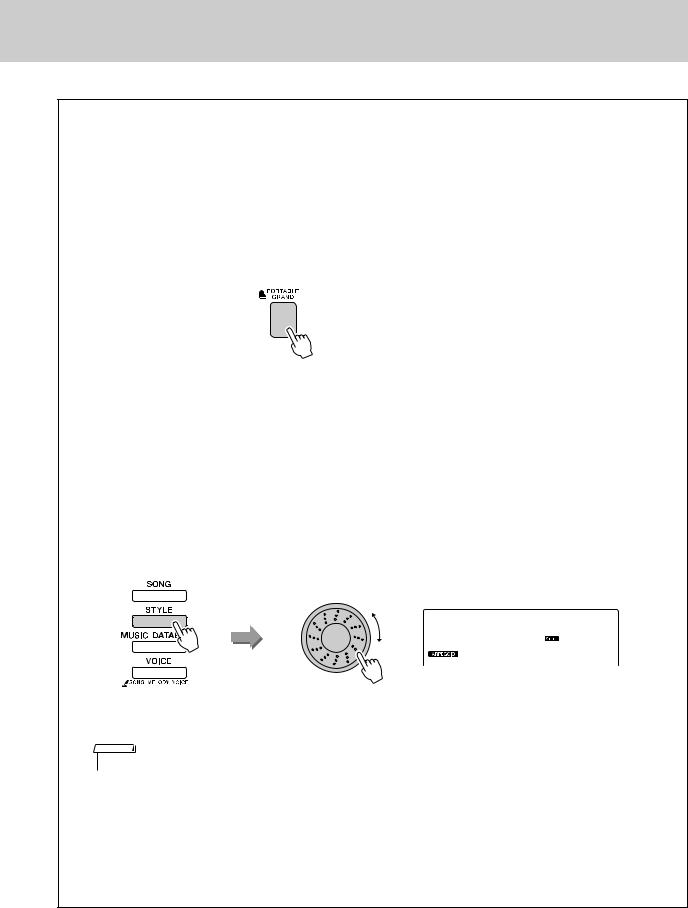
Creating Arpeggios
Create a Pop Tune
You can play a style and specify the style chords with your left hand while playing arpeggios with your right hand to create interesting sonic textures and backgrounds.
1 Select the keyboard voice (page 28).
For this example we’ll use a grand piano voice, so press the [PORTABLE GRAND] button. This convenient voice selection method lets you instantly select a voice with a single button press.
2 After turning the arpeggio function on, select an arpeggio type (steps 1 and 2 on the preceding page).
For this example select “02 DownOct”.
That completes preparation to use the arpeggio function.
3 Select the style you want to play along with the arpeggio function.
A “style” is an automatic accompaniment pattern.
Press the [STYLE] button and the name of the currently selected style will appear in the display. Rotate the dial to select the desired style. For this example we’ll use the “002 8BtModrn” (8 Beat Modern) style.
8BtModrn
002
NOTE
• Refer to “Playing Styles” on page 33.
16 PSR-E413 Owner’s Manual
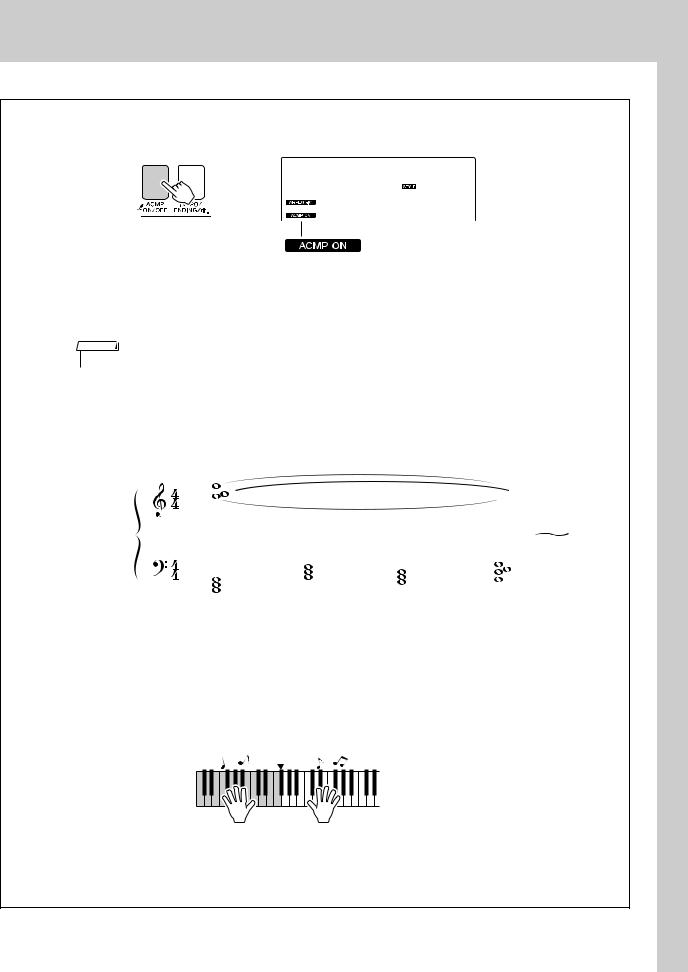
Creating Arpeggios
4 Press the [ACMP ON/OFF] button to turn auto accompaniment on.
8BtModrn
002
The ACMP ON icon will appear.
When auto accompaniment is turned on, the left-hand section of the keyboard is used only for specifying accompaniment chords.
NOTE
• Refer to “When automatic accompaniment is on ...” on page 34.
5
6
Press the [START/STOP] button.
The rhythm accompaniment will start.
Begin playing.
|
|
|
|
|
|
|
|
|
|
|
|
|
|
|
|
|
|
|
|
|
|
|
|
|
C |
Am |
F |
G7sus4 |
|
|
|
|
|
|
|
|
|
|
|
|
|
|
|
|
|
|
|
|
|
|
|
|
|
|
|
|
|
|
|
|
|
|
|
|
|
|
|
|
|
|
|
Listen carefully to the rhythm of the style, then play the notes shown in the score at the beginning of a measure. The style and arpeggio will begin playing together.
The accompaniment will change accordingly each time you play a new left-hand chord. Of course you can also change your right-hand fingering to produce interesting changes. If you’re not comfortable with right-hand playing yet, you could use the performance assistant technology feature described on page 23. When the performance assistant feature is on, playing any right-hand key will always produce musically appropriate notes!
Split point
Whenever you’re playing a style as well as a right-hand part, be sure that your left hand plays only to the left of the split point and your right hand plays only to the right of the split point. (page 30)
PSR-E413 Owner’s Manual 17
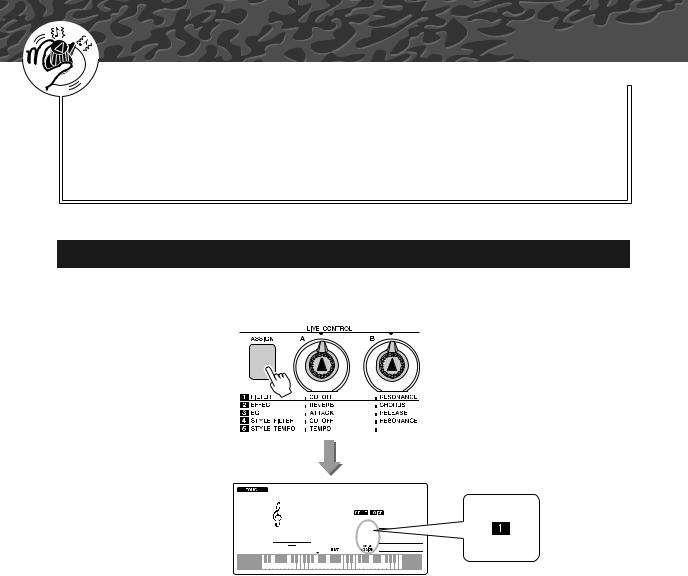
|
k |
c |
|
i |
|
u |
|
Q |
|
Guid e
Create Original Sounds 

The two knobs located in the lower left area of the panel can be used to add variations to the sound being played, transforming the sound in a variety of musical ways. Filter, envelope generator, and other effects can be assigned to the two knobs as required. In this section we’ll explain how effects can be assigned to the knobs, and provide a few tips for their use.
Assigning Effects to the Knobs
Repeatedly press the [ASSIGN] button to sequentially select the five effect combinations provided: z → x → c → v → b → z → ... etc. The currently selected combination is shown in the display.

 GrandPno
GrandPno
 001
001

 001
001
|
|
|
|
|
|
|
|
|
|
|
|
|
|
|
|
|
|
|
|
|
|
|
|
|
|
|
|
|
|
|
|
|
|
|
|
|
|
|
|
|
|
|
|
|
|
|
|
|
|
|
|
|
|
Number/Effect |
|
|
|
|
|
|
|
|
|
|
Knob A |
|
Knob B |
|||||||||||||
|
|
|
|
|||||||||||||||||||||||
z Filter |
Filter Cutoff |
|
Filter Resonance |
|||||||||||||||||||||||
|
|
|
|
|||||||||||||||||||||||
x Effect |
Reverb Send Level |
|
Chorus Send Level |
|||||||||||||||||||||||
|
|
|
|
|||||||||||||||||||||||
c EG |
Attack Time |
|
Release Time |
|||||||||||||||||||||||
|
|
|
|
|||||||||||||||||||||||
v Style Filter |
Filter Cutoff |
|
Filter Resonance |
|||||||||||||||||||||||
|
|
|
|
|||||||||||||||||||||||
b Style Tempo |
Tempo |
|
–No Effect– |
|||||||||||||||||||||||
|
|
|
|
|
|
|
|
|
|
|
|
|
|
|
|
|
|
|
|
|
|
|
|
|
|
|
The assignable knob effects are pre-programmed in the pairs listed above.
It is not possible to assign different effect combinations.
z–c affect the main and dual voices only. Split voices will not be affected. Styles and songs will also not be affected.
v–b affect styles only.
18 PSR-E413 Owner’s Manual
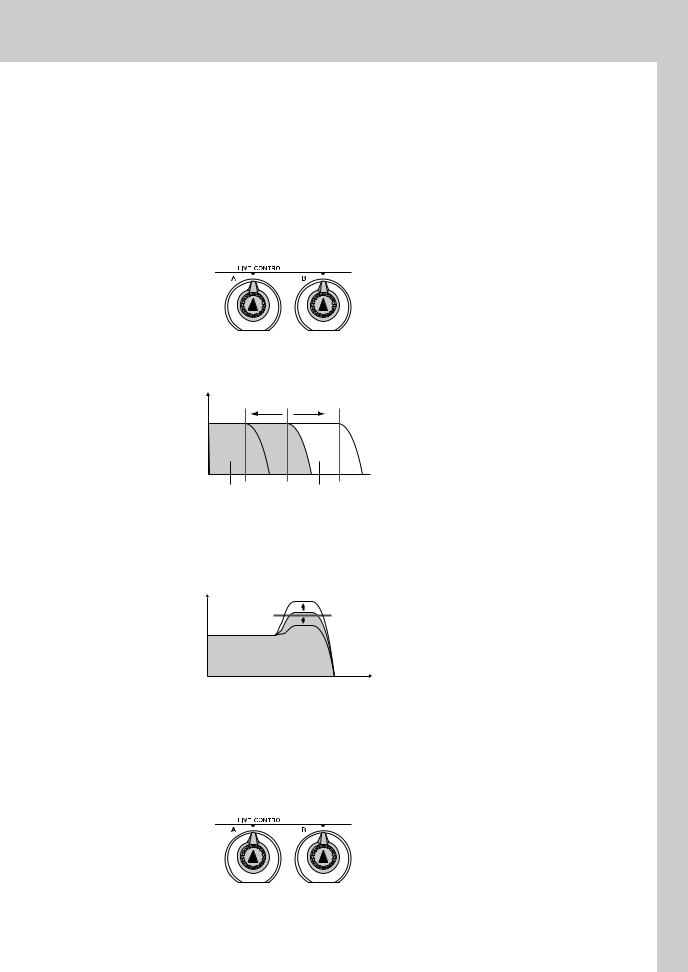
Create Original Sounds
z Filter
Filter effects shape sound by allowing only a specified range of frequencies to pass and/or by producing a resonance peak at the filter’s “cutoff” frequency. Filter effects can be used to create a range of synthesizer-like sounds.
* Filter effects can sometimes cause distortion in the bass frequencies.
Some hints for using the filter effects are provided on page 22.
Filter Filter
Cutoff Resonance
Knob A adjusts the filter’s cutoff frequency, and therefore the brightness of the sound.
Level
Cutoff Frequency
 Frequency
Frequency
Frequencies in this |
Frequencies in this |
range are passed. |
range are cut off. |
Knob B adjusts the amount of resonance applied at the filter’s cutoff frequency. Increasing the resonance emphasizes the frequencies at the cutoff frequency, and thus “strengthens” the perceived effect of the filter.
Level |
Resonance |
Frequency |
x Effect
Reverb reproduces the acoustic ambience of a concert hall or club, while chorus produces a layered “multi-instrument” effect.
Reverb Chorus
Send Level Send Level
Knob A adjusts the depth of the reverb effect, and Knob B adjusts the depth of the chorus effect.
PSR-E413 Owner’s Manual 19
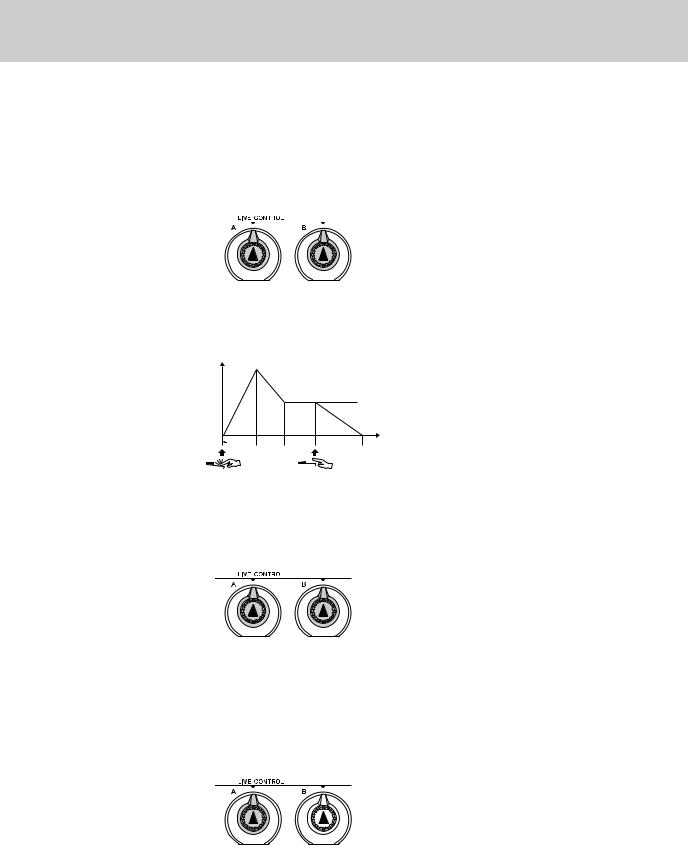
Create Original Sounds
c EG (Envelope Generator)
Envelope Generator effects determine how the level of the sound varies over time. You can make the attack faster for a more percussive sound or slower for a violin-like sound, for example. Or you can lengthen or shorten the sustain to most ideally match the music.
Attack Release
Time Time
Knob A adjusts attack time (the amount of time it takes the sound to reach maximum level when a key is played).
Knob B adjusts release time (the amount of time it takes for the sound to decay to silence after a key is released).
Level |
Sustain Level |
Time |
ATTACK 
 DECAY
DECAY 
 RELEASE
RELEASE 
Key Played Key Released
v Style Filter
Filter Filter
Cutoff Resonance
In this case the knobs apply the filter effect to the style being played. Knob A and Knob B have the same functions as for “z Filter” described on the preceding page.
b Style Tempo
Tempo |
–No Effect– |
Knob A adjusts the tempo of the style and arpeggios. Rotating the knob clockwise increases the tempo while rotating it counterclockwise decreases the tempo. The knob’s center position produces the initial default tempo.
20 PSR-E413 Owner’s Manual
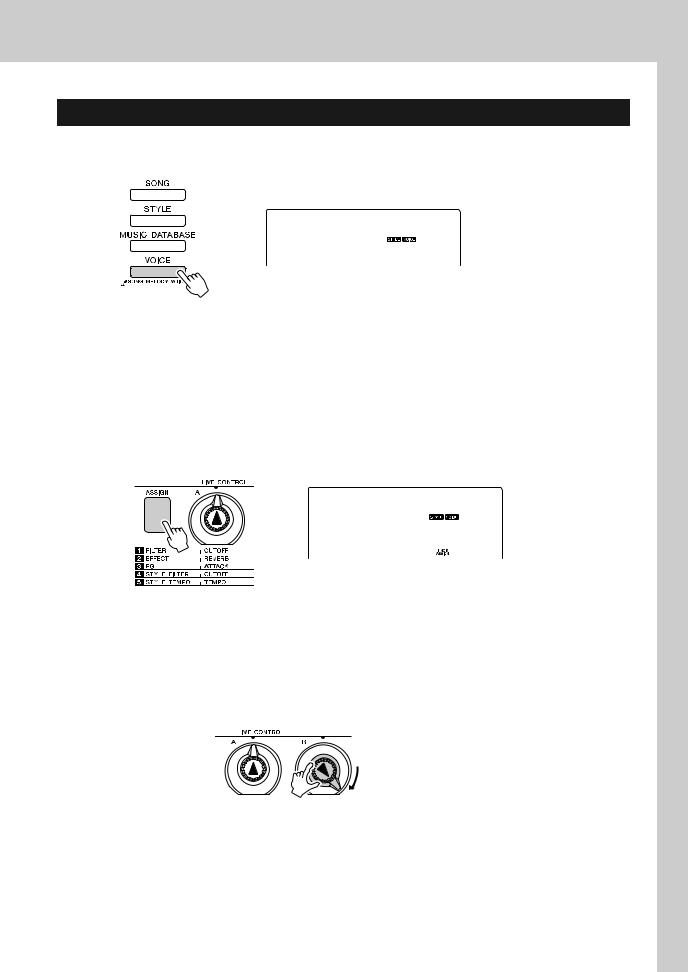
Create Original Sounds
Using the Knobs
1 Select the voice you want to play on the keyboard.
SquareLd
097
The name of the currently selected voice will appear in the display when you press the [VOICE] button. Use the dial to select the desired voice. For this example we want to use a synth-lead type voice, so select “97 SquareLd” (Square-wave Lead).
2 Press the [ASSIGN] button as many times as necessary to select “z FILTER” (“z” will appear in the display).
SquareLd
097
 “z” appears here.
“z” appears here.
Knob A can now be used to adjust the filter cutoff frequency, and Knob
B can be used to adjust the resonance.
3 Rotate Knob B to its maximum setting (all the way to the right).
Filter Filter
Cutoff Resonance
Rotating the knob to the right while the volume is set to a high level can result in distortion. If this occurs, reduce the volume level.
PSR-E413 Owner’s Manual 21

Create Original Sounds
4 Play with the right hand while operating Knob A with the left hand.
Filter Filter
Cutoff Resonance
If you select a different keyboard voice the knobs will be reset and the ideal settings for the selected voice will be automatically recalled. In the same way, if the “v STYLE FILTER” effect is selected, the knobs will be reset if a different style is selected. If you create an original setting you like, it might be a good idea to save it in the instrument’s Registration Memory (page 80) so you can recall the same settings again at any time. You can also record performances using original sounds you’ve created (page 52).
The chart below lists some interesting ways to use the various effects that can be assigned to the knobs.
Changing the knob settings does not immediately change the sound. Newly assigned effects will only change the sound when the knobs are first operated after the new effect has been selected.
● Some Ideas for Using the Knobs
Number/Effect |
Try This |
|
|
|
|
z FILTER |
Select a synth-type lead or pad voice (page 106). Turn Knob B all the way up and operate Knob A |
|
while playing for some spacey, floating 1980’s effects. |
||
|
||
|
|
|
x EFFECT |
Select a voice that sounds as though it already has reverb and chorus effects applied, and turn |
|
Knob A and Knob B all the way down to hear the “direct” sound of the voice.You can then turn the |
||
|
Knob A and Knob B settings up to add extra impact and richness to the voice. |
|
|
|
|
c EG |
Select a piano voice, and turn Knob B all the way up and Knob A to about the 3 o’clock position. |
|
This should give you a majestic, organ-like sound. The attack time is quite long so play the keys |
||
|
and hold them to let the sound come in fully. Ideal for slow pieces. |
|
|
|
|
v STYLE FILTER |
Select style 39, Euro Trance. Turn accompaniment on and start style playback (page 34). Set |
|
Knob B to about 3 o’clock, and Knob A to about 8 o’clock. The overall sound of the style should be |
||
|
a bit muffled, with the drums emphasized for solid rhythmic impact. |
|
|
|
|
b STYLE TEMPO |
Play a style and/or arpeggio (page 14) and use Knob A to adjust the tempo. |
|
|
|
22 PSR-E413 Owner’s Manual
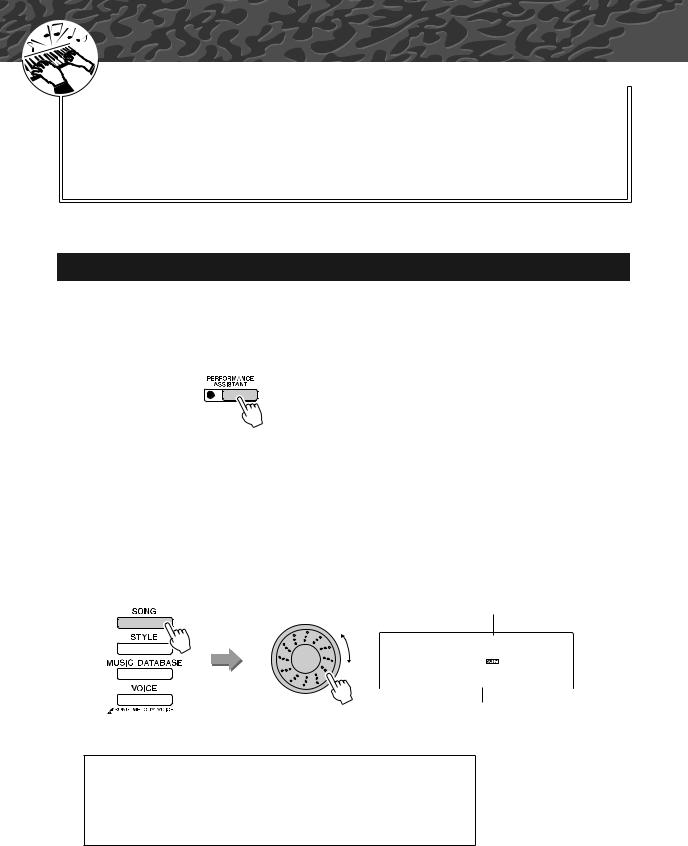
|
k |
c |
|
i |
|
u |
|
Q |
|
Guid e
The Easy Way to Play Piano 
This instrument includes a performance assistant technology feature that lets you play along with a song and sound like a great pianist (even though you might be making lots of mistakes)! In fact, you can play any notes and still sound good!
So even if you can’t play piano and can’t read a note of music, you can have some musical fun. It’s never too late to start learning!
Refer to page 25 for more information on using performance assistant technology to help you play.
Play with Both Hands
1 Press the [PERFORMANCE ASSISTANT] button.
The indicator lights when the performance assistant technology feature is on.
Press the [PERFORMANCE ASSISTANT] button to turn the function on or off.
2 Select a song.
Press the [SONG] button, and the song number and name will be displayed. You can use the dial or other selection controls to select a different song.
For this example try selecting the “010 AveMaria”.
Song name
AveMaria
010
Song number |
The song displayed here |
|
will be played. |
● What is a “Song”?
Of course you know the normal meaning of the word, but for this instrument the term “song” also refers to the data that makes up a piece of music. You can listen to the songs, use them for lessons, and use them with a range of other functions (page 39).
PSR-E413 Owner’s Manual 23

The Easy Way to Play Piano
3 Press the [
 ] (START/STOP) button.
] (START/STOP) button.
Adjusts volume.
Song playback will begin.
The basic pattern will repeat. Listen to four measures while memorizing the basic pattern. It’s your turn to play the part from the fifth measure.
4 Play on the keyboard.
Before |
After |
|
|
|
|
||||||||||||||||||||||||||||
|
|
|
|
|
|
|
|
|
|
|
|
|
|
|
|
|
|
|
|
|
|
|
|
|
|
|
|
|
|
|
|
|
|
|
|
|
|
|
|
|
|
|
|
|
|
|
|
|
|
|
|
|
|
|
|
|
|
|
|
|
|
|
|
|
|
|
|
|
|
|
|
|
|
|
|
|
|
|
|
|
|
|
|
|
|
|
|
|
|
|
|
|
|
|
|
|
|
|
|
|
|
|
|
|
|
|
|
|
|
|
|
|
|
|
|
|
|
|
|
|
|
|
|
|
|
|
|
|
|
|
|
|
|
|
|
|
|
|
|
|
|
|
|
|
|
|
|
|
|
|
|
|
|
|
|
|
|
|
|
|
|
|
|
|
|
|
|
|
|
|
|
|
|
|
|
|
|
|
|
|
|
|
|
|
|
|
|
|
|
|
|
|
|
|
|
|
|
|
|
|
|
|
|
Play the score on the left along with the accompaniment using both hands. You can even play the same keys over and over: C, E, G, C, E, G, C, E. Performance assistant technology will make sure that the notes will come out as if they were played according to the score on the right. Keep playing, and performance assistant technology will continue to “correct” the notes that you play.
You can stop song playback at any time by pressing the [ 
 ] (START/
] (START/
STOP) button.
24 PSR-E413 Owner’s Manual
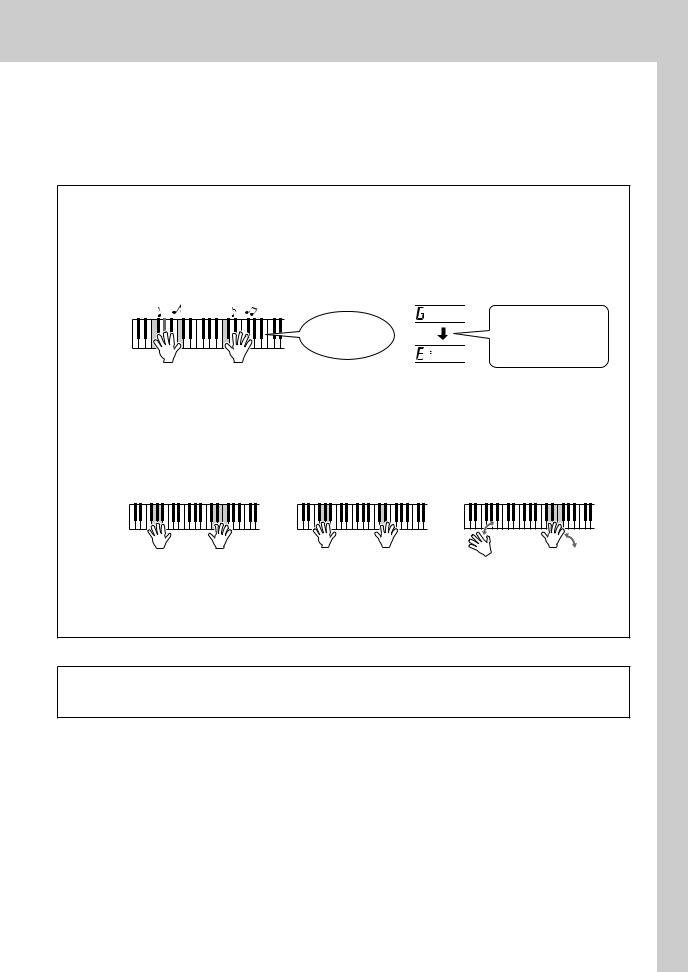
The Easy Way to Play Piano
5 Press the [PERFORMANCE ASSISTANT] button to turn the performance assistant technology feature off.
The complete score for Ave Maria is provided on page 102.
Use the Performance Assistant to Play Like a Pro!
To begin, try to feel the rhythm of the song. Then, with your hands spread as shown in the illustration, simply play the keyboard alternately with your left and right hands (any notes will do).
Sounds like you’re playing the right notes!
You will get even better results if you match your left-hand rhythm to the rhythm of the chord indicator in the display.
How does it sound? You’ll get acceptable results no matter where you play thanks to performance assistant technology!
Next try the three playing methods illustrated below. Different ways of playing produce different results.
●Play with the left and right hands at the same timing—type 1.
Play 3 notes at once with your right hand.
●Play with the left and right hands at the same timing—type 2.
Play 1 note at a time with your right hand (for example: index finger → middle finger → ring finger).
●Play alternately with the left and right hands—type 3.
Play 3 notes at once with your right hand.
Once you get a feel for it, try playing chords with your left hand and a melody with your right ... or any other combination.
To use the performance assistant technology feature it is necessary to play a song that includes chord data, or a style with auto accompaniment on.
If a song includes the required data, the chords are shown on the right side of the display (page 59).
PSR-E413 Owner’s Manual 25
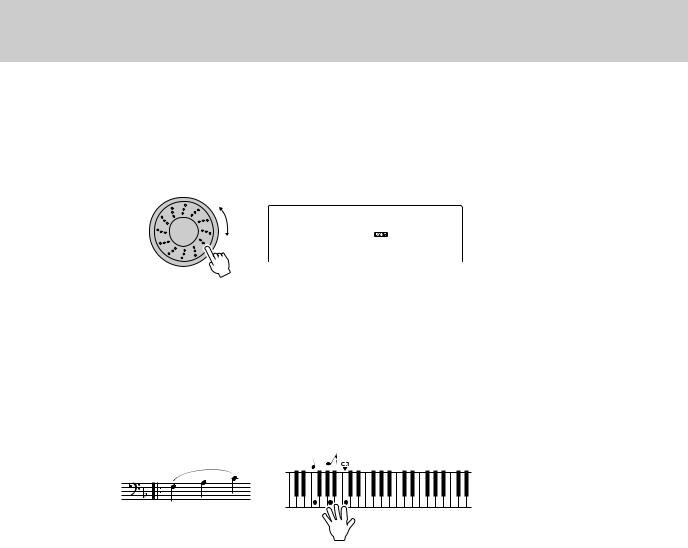
The Easy Way to Play Piano
1
2
3
Next try playing the Chopin Nocturne.
The procedure is that same as that described for playing Ave Maria on pages 23–25. Select “011 Nocturne”.
Nocturne
011
Listen to eight measures, then begin playing from the ninth measure.
Play the keys shown in the illustration. Keep playing F, A and C with your left hand and the correct notes will sound as the song proceeds. When you get used to playing the left hand part, refer to “The Easy Way to Play Piano” on page 23 and try adding the right-hand part.
Press the [PERFORMANCE ASSISTANT] button to turn the performance assistant technology feature off.
The complete score for Nocturne is provided on page 104.
26 PSR-E413 Owner’s Manual

The Easy Way to Play Piano
Change the Song Tempo
When using the performance assistant technology or in other situations in which the tempo of the song is too fast or too slow for you, you can change the tempo as required. Press the [TEMPO/TAP] button. The tempo display will appear and you can use the dial, the [+] and [-] buttons, or the [0] to [9] number buttons to set to tempo to anywhere from 011 and 280 quarter-note beats per minute.
Tempo
090
Current tempo value
You can return to the original tempo by simultaneously pressing the [+] and [-] buttons.
● About the Beat Display
The arrow marks in the beat display flash in time with the rhythm of the song or style.
|
|
|
|
|
|
First beat of measure |
|
Third beat |
|
||
|
|
|
|
|
|
|
Second beat |
|
Fourth beat |
||
PSR-E413 Owner’s Manual 27
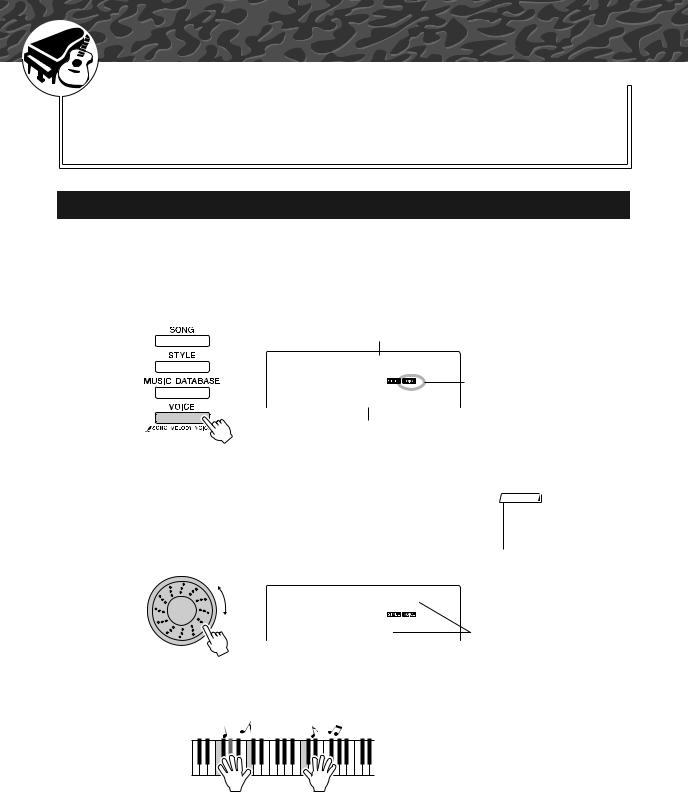
|
k |
c |
|
i |
|
u |
|
Q |
|
Guid e
Try Playing a Variety of Instrument Voices
In addition to piano, organ, and other “standard” keyboard instruments, this instrument has a large range of voices that includes guitar, bass, strings, sax, trumpet, drums and percussion, sound effects … a wide variety of musical sounds.
Select and Play a Voice—MAIN
This procedure selects the main voice you will play on the keyboard.
1 Press the [VOICE] button.
The voice number and name will be displayed.
Voice name
GrandPno
001
Appears when the Voice mode is engaged.
Voice number
2 Select the voice you want to play.
While watching the displayed voice name rotate the dial. The available voices will be selected and displayed in sequence. The voice selected here becomes the main voice.
For this example select the “092 Flute” voice.
NOTE
• You can also select the voice using the CATEGORY [f ] and [r ] buttons after pressing the [VOICE] button. (page 58)
Flute
092
Select 092 Flute
3 Play the keyboard.
Try selecting and playing a variety of voices.
28 PSR-E413 Owner’s Manual
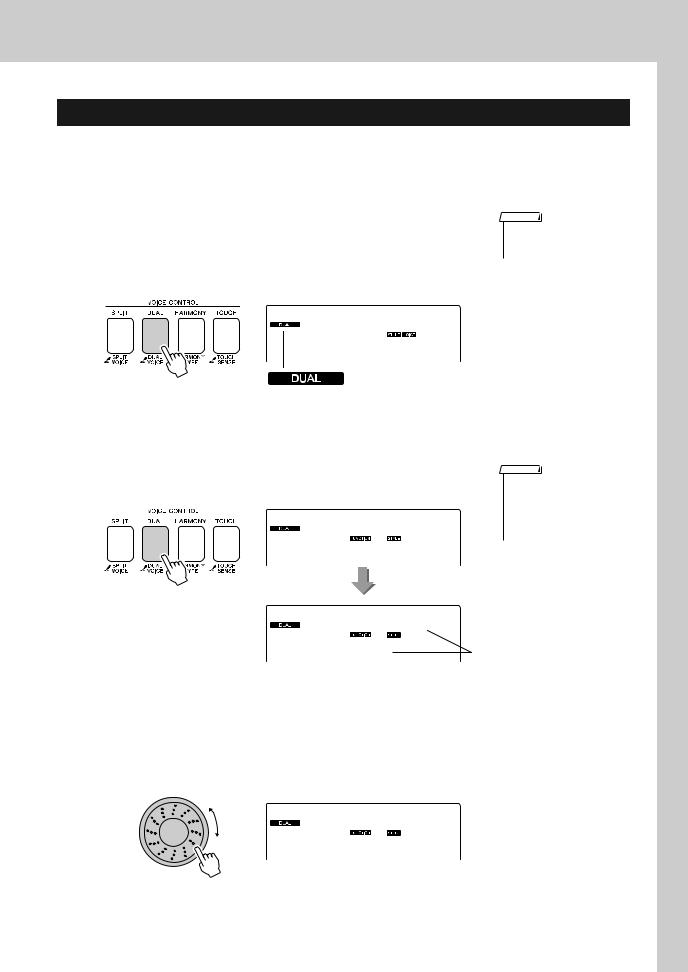
Try Playing a Variety of Instrument Voices
Play Two Voices Simultaneously—DUAL
You can select a second voice which will play in addition to the main voice when you play the keyboard. The second voice is known as the “dual” voice.
1 Press the [DUAL] button.
The [DUAL] button turns the dual voice on or off.
When turned on the dual voice icon will appear in the display. The currently selected dual voice will sound in addition to the main voice when you play the keyboard.
NOTE
•The dual voice feature cannot be used during a song lesson (page 43).
Flute
092
Dual voice icon
2 Press and hold the [DUAL] button for longer than a second.
“D.VOICE” appears in the display for a few seconds, then the currently selected dual voice will be displayed.
D.Voice
NOTE
• You can also select the Dual Voice display by pressing the [FUNCTION] button and then using the CATEGORY [f ] and [r ] buttons to select the “D.Voice” item.
Hold for longer than a second
Marimba
110 |
The currently selected |
|
dual voice |
Select the desired dual voice. |
|
3 Watch the displayed dual voice and rotate the dial until the voice you |
|
want to use is selected. The voice selected here becomes the dual voice. |
|
For this example try selecting the “109 Vibraphone” voice. |
|
Vibes |
|
109 |
|
PSR-E413 Owner’s Manual 29

Try Playing a Variety of Instrument Voices
4 Play the keyboard.
Two voices will sound at the same time.
Try selecting and playing a range of dual voices.
Play Different Voices with the Left and Right Hands—SPLIT
In the split mode you can play different voices to the left and right of the keyboard “split point”. The main and dual voices can be played to the right of the split point, while the voice played to the left of the split point is known as the “split voice”. The split point setting can be changed as required (page 72).
Split point
Split voice Main voice and dual voice
1 Press the [SPLIT] button.
The [SPLIT] button turns the split voice on or off.
When turned on the split voice icon will appear in the display. The currently selected split voice will sound to the left of the keyboard split point.
NOTE
•The split voice feature cannot be used during a song lesson (page 43).
Flute
092
Split voice icon
2 Press and hold the [SPLIT] button for longer than a second.
“S.VOICE” appears in the display for a few seconds, then the currently selected split voice will be displayed.
S.Voice
NOTE
• You can also select the Split Voice display by pressing the [FUNCTION] button and then using the CATEGORY [f ] and [r ] buttons to select the “S.Voice” item.
Hold for longer than a second
FngrBass
042 |
|
The currently selected |
|
||
|
|
SPLIT voice |
30 PSR-E413 Owner’s Manual
